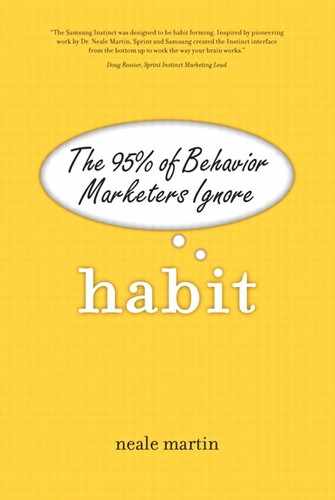8. Behavioral Training
In Part I, the implications of the remarkable discovery that our unconscious minds control most our behavior. Part II briefly updated basic marketing concepts based on this insight. But simply knowing that our customer’s unconscious mind is influencing behavior isn’t very helpful. This last section, introduced by “Of Google and Cigarettes,” provides a blueprint for working with our customer’s habitual and executive minds to become the customers’ habit. The short version is simple: Treat your customers like dogs.
Although this sounds particularly counterintuitive, this idea is based on one of the most heavily researched and validated areas in psychology. We don’t have established marketing rules to guide us, but we do have a sound, well-researched platform available to help: behavioral training. Although this discipline comes from the world of behavioral biology and animal training, it has been applied to a wide set of human applications, including working with autistic children and amateur and professional athletes.
Many people object to behavioral conditioning because they misunderstand the habit formation process. They believe that the reinforcer is essentially buying behavior and that it must be maintained if the behavior is to persist. The goal of habit formation is to automate behavior so it doesn’t need to be externally reinforced.
The habitual mind is nonverbal, so it doesn’t learn by reading or listening to an explanation. It learns unconsciously through associating an action with an outcome. This is the system we must influence. This idea is foreign to most of our marketing thought, which focuses on either conscious appeals to action or indirect appeals to emotion.
Anyone taking psychology courses after 1965 likely encountered behaviorism and its most famous advocate, B. F. Skinner. Although behaviorism made numerous advances in our understanding of animal and human behavior, it rejected what was going on inside the black box of the conscious mind. If behaviorists couldn’t observe it, it didn’t matter. Skinner, an atheist, further alienated the general public with his books Walden Two and Beyond Freedom and Dignity, in which he questioned the existence of free will. However, early behaviorists were on to something very important.
In the first section of the book, we saw how scientists can now peer inside the black box using fMRI, PET scans, and other advanced techniques. This gives us a much more balanced view of both executive and habitual mind functioning. We can now combine Skinner’s insights with advances in cognitive psychology to radically rethink our approach to customers and the marketplace without denying God’s existence or man’s free will.
We now know that the executive mind is real and that places in our minds house our sense of identity and morality. We understand that our mirror neurons connect us intimately to our fellow man in ways Skinner could never have imagined. We understand how emotions help us better interact with the world and make decisions. But we also know that habits are formed by the repetition of behaviors, actions real people perform in real situations to solve problems.
Therefore, companies must create programs oriented around behavioral outcomes instead of attitudes and beliefs. This means focusing on not just the transaction, but on every behavior leading up to and after the transaction. This requires marketers, managers, executives, product designers, retail outlets, and service companies to radically rethink their approach to the marketplace.
The rules for training the habitual mind are as real as those governing the movements of the planets. Although university researchers have examined these rules extensively, we see them implemented most successfully in the world of training. Whether with animal trainers working with dolphins or an instructor working with a novice golfer, the results from using these techniques are effective and reliable.
Behavioral training is effective because it works with the way the habitual mind learns. The habitual brain learns the same way a dog learns. The power of the executive brain is its ability to think abstractly about the world, but the power of the habitual brain is its ability to interact with the world on its own terms.
“Training customers” sounds manipulative and condescending, but it’s not. “Training customers” means working with, not against, their habitual minds. Your customers must be trained on how to get to your store, where to look for your services, and how to navigate your web site. If they’re not trained, they need to use their executive mind, which is inefficient and frustrating.
An obvious byproduct of this line of thinking is the need to make your products, services, and customer interfaces as intuitive as possible. Habits are formed much faster and more reliably with simple, elegant designs and interfaces.
Customers are being trained all the time, but haphazardly by you, the environment, and your competitors. Training customers to use your products and services with minimal effort requires reinforcing specific behaviors in a timely fashion. Let’s look at how behavioral training works.
